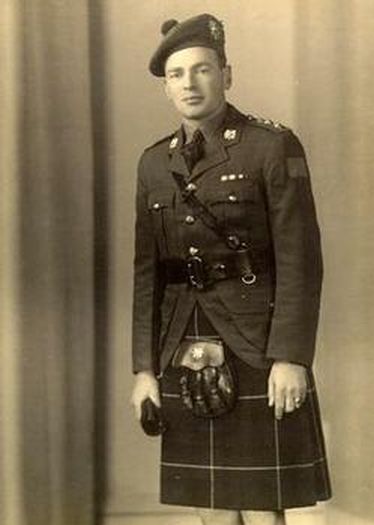Anderson, John MacMorran
- Date of birth:
- February 19th, 1913 (Edinburgh/Midlothian, Great Britain)
- Date of death:
- January 2004 (Oakville/Ontario, Canada)
- Nationality:
- Canadian
Biography
Jock Anderson studied Theology at Knox College in Toronto and tried to enlist with the 48th Highlanders in 1939. He was advised by the recruiters to continue to studies.
His first job was a minister at a church in Port Elgin, Ontario.
In 1942 Anderson joined the Canadian Army and was assigned as Protestant Chaplain to the Highland Light Infantry of Canada, 3rd Division. He landed at Normandy on D-Day, June 6, 1944. His experiences as are recounted by Brigadier General Denis and Shelagh Whitaker (RMC 1933) in `Victory at Falaise` and `Tug of War`.
Anderson went on to serve as a Protestant Chaplain at the Saint Martin Protestant Chapel at RMCC in Kingston from 1955-1958
After RMC, he was posted to London in 1958. He was later posted to Ortona Barracks in Oakville where he remained until his retirement in 1967. He purchased `Worn Doorstep` a historic landmark, in 1966 and renovated it extensively as a family home. After leaving the military, he worked for a few years as a probation officer and also became very involved with a local church.
Do you have more information about this person? Inform us!
- Period:
- Second World War (1939-1945)
- Rank:
- Acting Captain
- Unit:
- Highland Light Infantry of Canada, 9th Canadian Infantry Brigade, 3rd Canadian Infantry Division, Canadian Army
- Awarded on:
- November 4th, 1944
"On 5 march 1945 H/Caplain John MacMorran Anderson, Canadian Chaplain Service, was padre attached to the Highland Light Infantry of Canada. The regiment launched an attack from Balberger Wald over a mile of open ground, along a forward slope. “C” and “D” Companies were pinned down by heavy machine-gun and small arms fire, and suffered over thirty casualties who had to be evacuated across the open ground under enemy fire.
Tanks were sent across the start line to go to the assistance of the two companies but these were knocked out by enemy tanks and self-propelled guns on the forward slope before reaching “C” and “D” Companies.
H/Captain Anderson, hearing of the casualties, proceeded forward on foot across the bullet-swept ground to “C” and “D” Companies. Finding many casualties who required immediate attention, he returned to the battalion headquarters area near the start line and organized two available jeeps and a party of volunteer stretcher bearers to return to the scene of the battle. Though warned that all tanks had been knocked out a few minutes before on the route, H/Captain Anderson led the jeep party back and forth across the open ground until all casualties were evacuated.
During the day, a carrier and a tank had been knocked out by mines on the route to the Regimental Aid Post. The enemy positioned a self-propelled gun and machine-guns to cover the defile thus caused and successfully prevented the use of the route by vehicles and marching personnel during the battle. H/Captain Anderson, knowing this, ignored the enemy fire and led his jeeps along the route. Although the enemy fired upon the jeeps and destroyed one of them, H/Captain Anderson continued to drive back an forth along the route throughout the battle.
By his complete disregard for his own safety, and by his outstanding courage and initiative under heavy fire, H/Captain Anderson successfully evacuated over thirty stretcher cases and thus saved the lives of many soldiers"
- Period:
- Second World War (1939-1945)
- Rank:
- Lieutenant
- Unit:
- 3rd Canadian Anti-tank Regiment, 3rd Canadian Infantry Division, Canadian Army
- Awarded on:
- June 16th, 1945
Lieutenant John Anderson has been I Troop Commander in the 3 Canadian Anti-Tank Regiment since the start of the 3 Canadian Infantry Division attack west from Nijmegen. I troop being a self propelled troop has invariably been up with the forward infantry despite the almost insurmountable water conditions prior to the crossing of the Rhine.
An excellent example of this officer's bravery was seen on the of 25 March 1945 during the North Nova Scotia Highlander's attack on Bienen. The infantry were pinned down by heavy machine gun fire from a self propelled gun which had already knocked out two British tanks. Lt Anderson was asked to knock this gun out. He immediately took over one of his own guns and personally directed it forward. To pin point the exact location of the enemy gun, Lt Anderson took one of his light machine guns to one side and swept the near vicinity of the enemy gun. This fire brought back heavy retaliatory fire by which his own gun was able to pin point the enemy and destroy the enemy equipment.
After the crossing of the Rhine, this officer and his troop were on two occasions given an infantry holding roll. Although rather unfamiliar with these infantry tactics, Lt Anderson organized his troop and by his own enthusiasm and example was able to do an outstanding job.
Second MC awarded as a bar for on the ribbon of the first MC.
Sources
- Photo 1:
- Photo: Oakville at War
- - FOWLER, T.R., Valour in the Victory Campaign, General Store Publishing House, Burnstown, 1995.
- ZUEHLKE, M., On to Victory, Douglas & McIntyre Publishers Inc., Vancouver, Canada, 2010.
- National Defence and the Canadian Forces
- Second Supplement to The London Gazette Issue 36850 published on the 19 December 1944
- Supplement to The London Gazette Issue 37138 published on the 19 June 1945
- e-Veritas - The Newsletter of the RMC Club of Canada
- Halton Images



